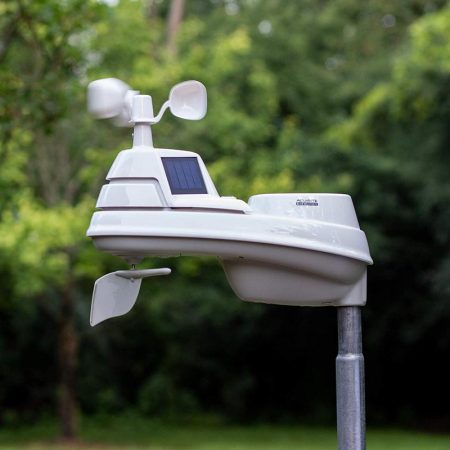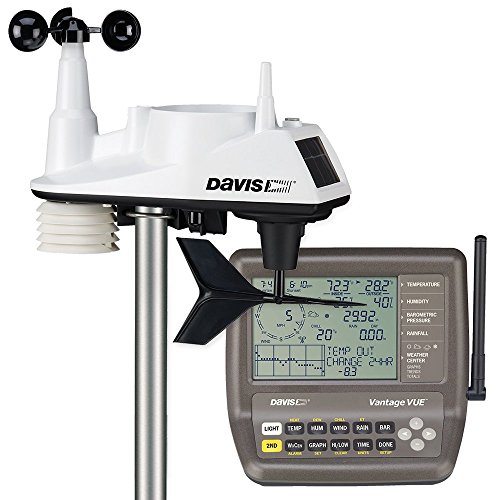No one wants to rely on talking head meteorologists in far away stations to find out about local weather conditions. How many people do you know who have said that their weather station is a complete joke and never seem to get anything right? That’s because their weather data comes from sensors that are very close to the studio. This means that if you live more than a few miles away, their data is irrelevant because it’s not really reporting local weather conditions.
Most suburban families live anywhere from 20 to 50 miles from the stations reporting their weather data. No one can make plans based on those distances! Weather, particularly rainfall, moves much faster than that.
What you need is an accurate way to forecast weather with real-time data with a personal weather station. These days, home weather stations are extremely affordable and just as accurate as the ones used by professionals! Most of them are easy to calibrate and install as long as you follow instructions.
We wrote some guidelines to help you learn how to find the right home weather stations, including common features, techniques to get the most accuracy out of your system, and more. After that, we will recommend our picks for the best weather station for a home in 2020 to help you narrow down the search with our weather station reviews.
Sensors
One of the most confusing things when it comes to buying a wireless weather station is trying to figure out what everything means. There are a lot of terms you may have heard that you’d be embarrassed to admit you don’t know the meaning of.
Many of the home weather stations can only be distinguished by their features and displays so it is important to know these terms and decide which ones are important to you.
The easiest term to understand is thermometers. Any decent weather system should be able to monitor the indoor temperature and outdoor temperature. More advanced stations will be able to determine temperature variants over time, averages, and daily highs and lows. Your personal weather station should come with both an outdoor and an indoor sensor.

Hygrometers are another common feature of a digital weather station. These tools measure humidity. A basic weather system can tell you outdoor humidity. Some even monitor indoor humidity. If you’re outside, and the humidity is high, you should expect it to rain soon. If you’re outside and in the South, the humidity will just be constantly high over summers. Your jeans start sticking to you and you’re always damp. A lot of different calculations come from the humidity sensors and indoor humidity is just as important as outdoor.
An anemometer measures wind speed and direction. Most look like little fans or windmills and spin clockwise or counterclockwise at varying rates of speed. If there is no wind, they will remain still.
Barometers measure atmospheric pressure or barometric pressure. Calculating barometric or atmospheric pressure can tell you when the weather is fluctuating or changing. Generally, changes will lead to sunshine or overcast skies and potentially even rain.
Speaking of rain, a rain gauge measures how much rainfall you have seen. This has a few different forms so you can find one that matches your aesthetics if you think it’s important.
Lightning detectors are also found on a wireless weather station. This is a recent addition to the more technologically-heavy home weather stations and a very recent addition to smaller home weather stations. If it is important to you, be prepared to spend a little extra. Having one can signal strikes from 25 miles away or more!
Display Console
Another important feature for a personal weather station is the display console. In fact, more often than not, the indoor display aesthetic and size will be the single determining factor when deciding which one to buy. Having a display that fits where you want it to go in your house is important. Being able to read it is, too.
If you have vision problems, consider purchasing a model with larger numbers or backlight features on the indoor display. Avoid any extra sensors because they will clutter your display. Some weather stations even come with smaller, portable indoor displays that simply show you time, temperature, and humidity. If that’s all you need, you can save yourself quite a bit of money.
Weather Station Reviews
Now, I’ll talk about some of my favorite systems. If you buy one of these, you can be confident that you made a solid decision and will have the best wireless weather station for your home.
Davis Vantage Vue
Prices pulled from the Amazon Product Advertising API on:
Product prices and availability are accurate as of the date/time indicated and are subject to change. Any price and availability information displayed on [relevant Amazon Site(s), as applicable] at the time of purchase will apply to the purchase of this product.
Davis has been making home weather stations for half a century and they were the first company to provide them to consumers. Their reputation for accurately reporting weather conditions is unparalleled. In fact, universities and science labs rely on their technology because it is so accurate and reliable.
The Vue is their moderate personal weather station. They also have a larger system capable of housing eight separate sensors if you want to spend a ton of money for some awesome features. But the Vantage Vue should work wonders for most home users.
It has an all-in-one sensor suite that monitors temperature, humidity, wind direction and speed. You have to find a good place for your sensor to ensure wind speed accuracy but because it is a Davis sensor, you can be sure that following their suggestions will result in accurate data.
AcuRite 06014 Pro Plus 5-in-1 Weather Sensor
Prices pulled from the Amazon Product Advertising API on:
Product prices and availability are accurate as of the date/time indicated and are subject to change. Any price and availability information displayed on [relevant Amazon Site(s), as applicable] at the time of purchase will apply to the purchase of this product.
The AcuRite weather station is much more budget-friendly than Davis models if you’re willing to sacrifice science lab level accuracy for still quite accurate local data. Their sensor is also a 5-in-1 that measures temperature, humidity, wind speed and direction, and rainfall. Their real-time weather data is transmitted every 36 seconds and is accurate up to 330 feet, so it’s pretty solid when it comes to range. It is compatible with the AcuRite Access and has an additional display console available for purchase.









